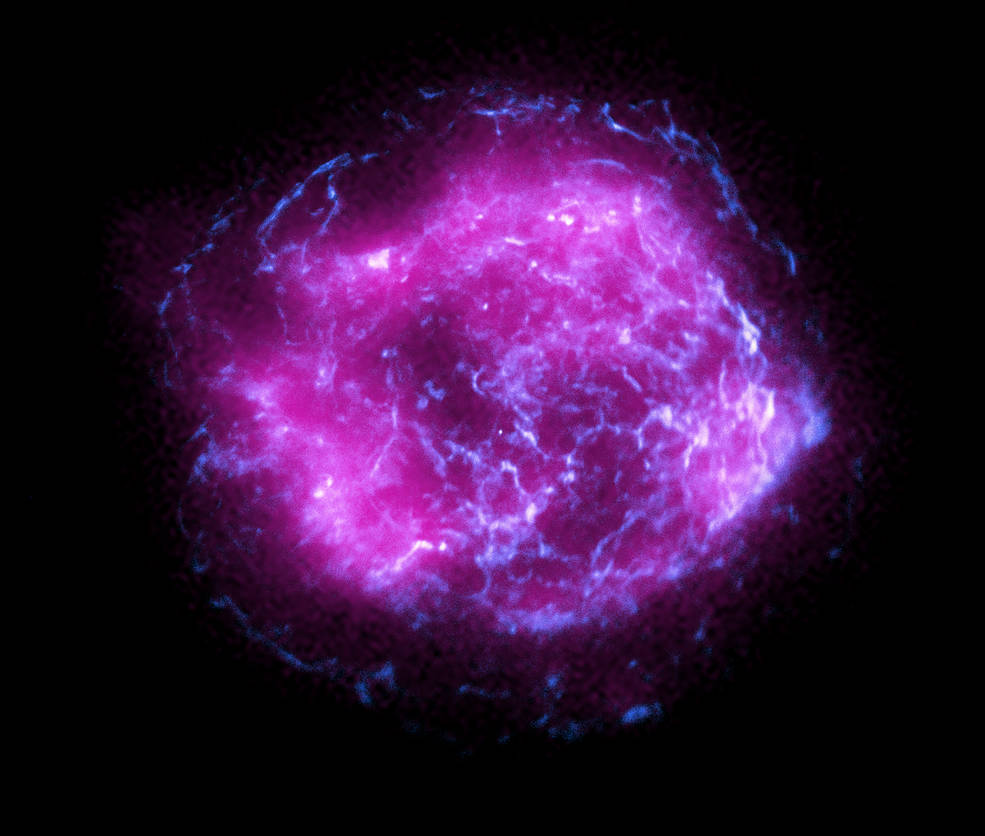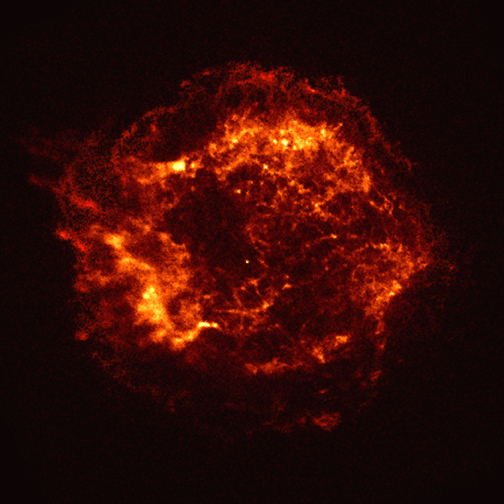1st image from NASA's new IXPE X-ray telescope looks like a ball of purple lightning

NASA's newly-launched X-ray hunting probe has snapped its first science image and — wow — it's spectacular.
The Imaging X-ray Polarimetry Explorer (IXPE) probe launched Dec. 9, 2021, on a mission to observe objects like black holes and neutron stars in X-ray light, shedding much-anticipated light on the inner workings of the cosmos. The probe spent its first month in space checking out its various systems to get ready to capture its first images, and now the IXPE team has released its very first science image.
The image shows Cassiopeia A, the remnants of a star that exploded as a supernova in the 17th century. That explosion sent shock waves outwards, heating up surrounding gasses and accelerating cosmic ray particles (high-speed electrons and atomic nuclei) to create a cloud of assorted matter, according to a statement from NASA. This cloud, as you can see in the striking image from IXPE, glows brilliantly in X-ray light.
Related: Our X-Ray universe: Amazing photos by NASA's Chandra X-Ray Observatory
It goes without saying that the image is visually stunning.
"The IXPE image of Cassiopeia A is bellissima, and we look forward to analyzing the polarimetry data to learn even more about this supernova remnant," Paolo Soffitta, the Italian principal investigator for IXPE at the National Institute of Astrophysics (INAF) in Rome, said in the NASA statement. ("Bellissima" means beautiful in Italian.)
Now, while the image's most striking feature is its almost-neon magenta color, it doesn't actually look like that in visible light. But this color, which represents X-ray radiation, is a helpful guide for scientists. The more saturated the color, the more intense the X-ray light. Additionally, veins of what resembles blue lightning in the image represent high energy X-rays seen by NASA's Chandra X-ray Observatory.
Get the Space.com Newsletter
Breaking space news, the latest updates on rocket launches, skywatching events and more!
While the two telescopes both observe X-rays, they have different kinds of detectors so, by working together, they can produce more complete and detailed data, according to the statement.
Chandra's first image was also of Cassiopeia A after it launched all the way back in 1999. Chandra's early observations revealed that, at the center of the remnant, there must be a compact object like a black hole or neutron star.

"The IXPE image of Cassiopeia A is as historic as the Chandra image of the same supernova remnant," IXPE principal investigator Martin C. Weisskopf said in the NASA statement. "It demonstrates IXPE's potential to gain new, never-before-seen information about Cassiopeia A, which is under analysis right now."
Email Chelsea Gohd at cgohd@space.com or follow her on Twitter @chelsea_gohd. Follow us on Twitter @Spacedotcom and on Facebook.
Join our Space Forums to keep talking space on the latest missions, night sky and more! And if you have a news tip, correction or comment, let us know at: community@space.com.

Chelsea “Foxanne” Gohd joined Space.com in 2018 and is now a Senior Writer, writing about everything from climate change to planetary science and human spaceflight in both articles and on-camera in videos. With a degree in Public Health and biological sciences, Chelsea has written and worked for institutions including the American Museum of Natural History, Scientific American, Discover Magazine Blog, Astronomy Magazine and Live Science. When not writing, editing or filming something space-y, Chelsea "Foxanne" Gohd is writing music and performing as Foxanne, even launching a song to space in 2021 with Inspiration4. You can follow her on Twitter @chelsea_gohd and @foxannemusic.









